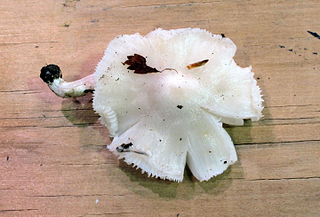| Melanomphalia | |
|---|---|
| Scientific classification | |
| Kingdom: | |
| Division: | |
| Class: | |
| Order: | |
| Family: | |
| Genus: | Melanomphalia M.P.Christ. |
| Type species | |
| Melanomphalia nigrescens M.P.Christ. | |
Melanomphalia is a genus of fungi in the family Tricholomataceae. The genus is monotypic, containing the single species Melanomphalia nigrescens, found in Europe. [1] The species was first described by M.P. Christensen in 1936. [2]

The Tricholomataceae are a large family of mushrooms within the Agaricales. Originally a classic "wastebasket taxon", the family included any white-, yellow-, or pink-spored genera in the Agaricales not already classified as belonging to e.g. the Amanitaceae, Lepiotaceae, Hygrophoraceae, Pluteaceae, or Entolomataceae.

Amparoina is a genus of fungi in the family Tricholomataceae. The genus contains two species found in South America.

Cellypha is a genus of fungi in the family Tricholomataceae. The widespread genus contains 10 species.
Clavomphalia is a genus of fungi in the family Tricholomataceae. It is a monotypic genus, containing only Clavomphalia yunnanensis, a Chinese species first described by German mycologist Egon Horak in 1987.
Conchomyces is a genus of fungi in the family Tricholomataceae. The genus was named and described scientifically by Casper van Overeem in 1927. The genus contains two species found in Indonesia.

Delicatula is a genus of fungi in the family Tricholomataceae. It was first described by Swiss mycologist Victor Fayod in 1889. The genus contains two widely distributed species.
Dennisiomyces is a genus of fungi in the family Tricholomataceae. Described by mycologist Rolf Singer in 1955, the genus contains five species found in South America.

Leucocortinarius is a genus of fungus in the family Tricholomataceae. It is a monotypic genus, containing the single species Leucocortinarius bulbiger, found in Europe.

Leucoinocybe is a fungal genus in the family Tricholomataceae. This genus is known to contain 3 species: Leucoinocybe lenta and Leucoinocybe taniae, found in Europe, and Leucoinocybe sulcata found in India.
Lulesia is a genus of fungi in the family Tricholomataceae. The genus contains three species found in tropical regions.

Mycenella is a genus of fungi in the family Tricholomataceae. The widespread genus contains 10 species, found mostly in temperate regions. Mycologist Rolf Singer circumscribed the genus in 1938.

Myxomphalia is a genus of fungi in the family Tricholomataceae. The genus has a widespread distribution in north temperate areas, and contains four species.
Phaeomycena is a genus of fungi in the family Tricholomataceae. The genus contains five species found in Asia and Africa.
Physocystidium is a genus of fungi in the family Tricholomataceae. This is a monotypic genus, containing the single species Physocystidium cinnamomeum. This species is found in Trinidad, and was originally described as new to science in 1951 as Collybia cinnamomea by mycologist R.W.G. Dennis; Rolf Singer transferred it to the then newly created genus Physocystidium in 1962.
Pleurella is a genus of fungi in the family Tricholomataceae. This is a monotypic genus, containing the single species Pleurella ardesiaca, found in New Zealand.
Porpoloma is a genus of fungi in the family Tricholomataceae. The genus contains about 12 species found predominantly in South America. Porpoloma was described by mycologist Rolf Singer in 1952 with P. sejunctum as the type species.
Stanglomyces is a genus of fungi in the family Tricholomataceae. This is a monotypic genus, containing the single species Stanglomyces taxophilus, found in South America. The species was described as new to science by Jörg Raithelhuber in 1985.
Pseudohygrophorus is a genus of fungi in the family Tricholomataceae. The genus is monotypic, and contains the single species Pseudohygrophorus vesicarius. The species was first described scientifically by the Czech botanist Josef Velenovský in 1939.

Albomagister is a genus of fungi in the family Tricholomataceae. The genus contains just one named species known from Tennessee and North Carolina, however two other undescribed species have been sequenced. Albomagister was described by mycologists Marisol Sánchez-García, Joshua Birkebak & P. Brandon Matheny in 2014 with Albomagister subaustralis as the type species.